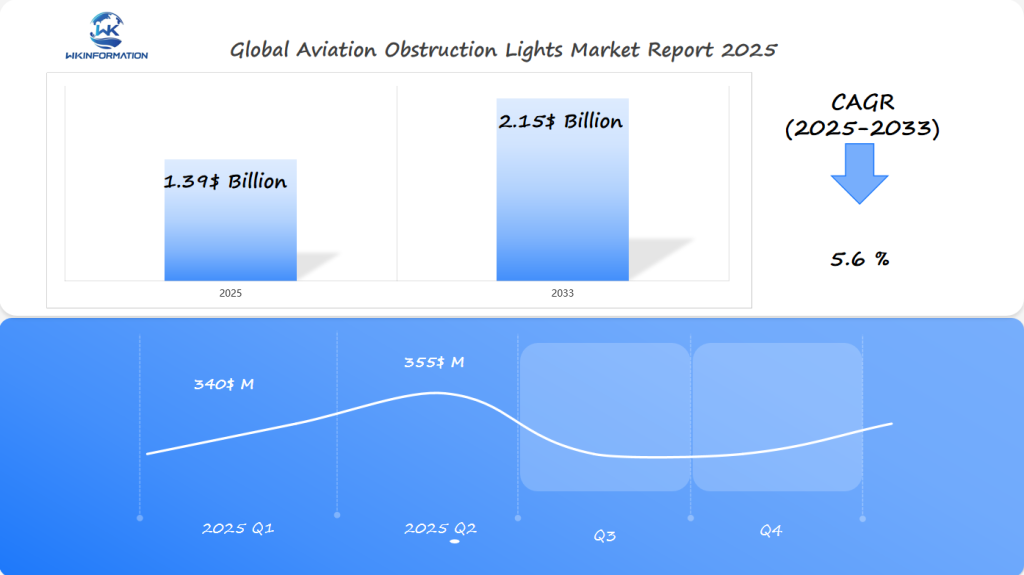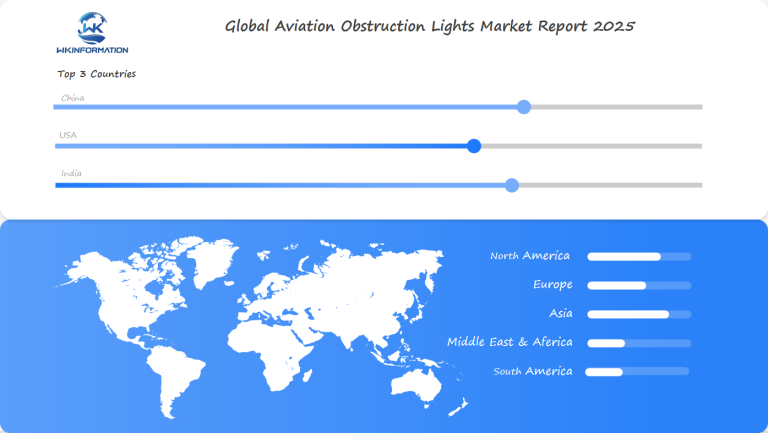Aviation Obstruction Lights Market: Unlocking $1.39 Billion Growth in 2025 Across China, USA, and India
Discover comprehensive insights into the Aviation Obstruction Lights market, exploring growth trends, technological advancements, and safety regulations. From LED innovations to smart integration solutions, learn how these essential safety devices are evolving to meet increasing air traffic demands and urbanization challenges while ensuring compliance with international aviation standards.
- Last Updated:
Market Outlook for Aviation Obstruction Lights in Q1 and Q2 2025
The global aviation obstruction lights market is projected to achieve significant growth in 2025, with an estimated market size of USD 1.39 billion for the year. Based on current trends and a CAGR of 5.6%, Q1 2025 is expected to see market revenues of approximately USD 340 million, while Q2 2025 is likely to reach around USD 355 million, reflecting a steady upward trajectory. Among the key markets, China, the USA, and India stand out as the most promising regions, driven by increasing air traffic, infrastructure development, and stringent safety regulations.
These countries are anticipated to contribute substantially to market expansion, making them critical areas for further study. For a detailed breakdown of regional dynamics, competitive landscapes, and future growth opportunities, explore the Wkinformation Research sample and full report. Unlock the insights needed to stay ahead in this evolving market!

Key Takeaways
- Global aviation safety technologies are experiencing rapid technological advancement
- Emerging markets are driving significant investment in obstruction lighting systems
- Regulatory compliance remains a critical factor in market expansion
- Technological innovation continues to reshape aviation safety standards
- Infrastructure development plays a crucial role in market growth
Upstream and Downstream Industry Chain Analysis: Understanding the Aviation Obstruction Lights Supply Chain
The aviation obstruction lights supply chain is a complex web of manufacturers, suppliers, and tech providers. It shows how raw materials get turned into products and reach customers worldwide.
Key parts of making aviation obstruction lights include:
- Advanced electronic component sourcing
- High-precision optical technology integration
- Specialized material selection
- Rigorous quality control protocols
Recently, the global supply chain has changed a lot. Technological innovations and world politics have made manufacturers adapt and be more flexible.
The effectiveness of aviation obstruction lights depends entirely on the integrity of their supply chain infrastructure.
Now, making these lights focuses on:
- Sustainable material procurement
- Streamlined production workflows
- Enhanced technological capabilities
- Reduced environmental impact
Working together is key for success in the aviation obstruction lights market. Partnerships between makers, tech integrators, and users help everyone stay ahead.
Trend Analysis: Current Developments and Future Directions in Aviation Obstruction Lights
The aviation obstruction lights market is seeing fast changes in technology. These changes are making safety and performance better. Now, we see a big move towards smarter and greener lighting for airports and airfields.
Important tech changes are leading to new ideas in the field:
- LED technology is making lights use less energy
- Solar-powered lights are cutting down costs
- Smart controls are making it easier to watch over these lights
The global market for aviation obstruction lights is set to grow by 5.6% from 2025 to 2033. China and India are leading the way in new tech, with Asia-Pacific expected to grow the most at 6.5%. Rules and safety standards are also driving tech forward.
Restriction Analysis: Challenges Facing the Aviation Obstruction Lights Industry
The aviation obstruction lights industry is facing big challenges. It needs smart strategies and new ideas to move forward. Keeping up with safety rules is a big part of this.
Companies must also deal with new tech and money issues.
Some major challenges are:
- Strict safety rules that need constant updates
- Higher production costs that make it hard to compete
- Global supply chain problems that mess up making things
- Needs to be more green
Keeping up with safety rules is a big hurdle for makers. With safety rules getting tougher worldwide, companies must spend a lot on research. The Surface Safety Metric (SSM) by the FAA in October 2019 shows how safety rules are changing.
Money issues also add to the problem. We’ll need 800,000 new pilots by 2039 and big investments in infrastructure. Companies that can handle safety rules and new tech will likely lead the market.
Here are some ways to tackle these problems:
- Invest in the latest tech
- Make making things more flexible
- Have strong quality checks
- Work closely with safety regulators
The aviation obstruction lights industry must keep growing to meet changing safety needs. It also needs to stay financially stable.

Geopolitical Analysis: How Global Politics Influence Aviation Obstruction Lights Production and Trade
The global aviation obstruction lights market is closely tied to complex global politics. These politics shape how trade happens around the world. Recent events have greatly changed how safety equipment for flying is made and shared across regions.
Important global politics affecting the aviation obstruction lights market include:
- Changes in trade policies among big economies
- How international relations shape supply chains
- New rules in key markets
The Russia-Ukraine conflict showed how global tensions can affect trade. By March 2022, 36 countries banned Russian airlines from flying over their skies. This caused big problems in flying worldwide and in related markets.
| Geopolitical Factor | Impact on Aviation Obstruction Lights Market |
|---|---|
| Trade Restrictions | More production happens locally |
| Economic Sanctions | Supply chains get reorganized |
| Regional Tensions | How to get into markets changes |
China, the United States, and India are key in aviation obstruction lights trade. Geopolitical factors keep changing the market, pushing for new ideas and partnerships.
With global politics getting more complex, makers and suppliers in the aviation obstruction lights market need to be flexible. They must deal with the complex world of international trade while staying competitive.
Segmentation Type Market Analysis: Aviation Obstruction Lights Market Segmentation by Type and Application
The aviation obstruction lights market is complex, with many product types and uses.
Product Type Diversity
There are three main types in the aviation obstruction lights market:
- LED Lights: Most energy-efficient and long-lasting option
- Xenon Lights: High-intensity illumination with superior visibility
- Incandescent Lights: Traditional technology with established performance
Application Landscape
Aviation obstruction lights are used in important areas:
- High-rise Buildings
- Airports
- Telecommunications Towers
“Over 60% of civil aviation accidents involve collisions with obstacles,” highlights the critical importance of effective aviation obstruction lighting.
Application Market Analysis: The Role of Aviation Obstruction Lights in Airfield Safety
Aviation obstruction lights are key to keeping airfields safe worldwide. They help prevent accidents by guiding pilots through complex airport areas. These lights are vital for airfield safety.
The safety of airfields is crucial. Obstruction lights are placed to warn pilots of dangers. This includes tall structures, runway edges, and important navigation points.
- Tall structures surrounding airports
- Runway perimeter boundaries
- Critical navigation points
- Telecommunication towers
Recent studies show big changes in aviation lighting. The Global Solar Aviation Lighting Market is expected to grow.
“Safety is our paramount concern in aviation infrastructure development.” – Aviation Safety Expert
Aviation obstruction lights are getting better. This is a big step forward in keeping air travel safe. It protects both the infrastructure and people’s lives.
Global Aviation Obstruction Lights Market Region Analysis: A Comparative Study of Regional Dynamics
The global aviation obstruction lights market is complex. It’s shaped by different technologies and economies. Each region has its own way of affecting the global market.
Looking at the regions, we see big differences in how technology is used and adopted:
- North America is a leader in using the latest lighting tech.
- Asia-Pacific is growing fast in the market.
- European markets focus a lot on safety rules.
The aviation obstruction lights market keeps changing. New markets offer chances for growth and new tech.
“Regional differences greatly affect global market plans and new tech in aviation safety lighting.”

China Aviation Obstruction Lights Market Analysis
The aviation obstruction lights market in China is growing fast. It’s a key part of the country’s changing infrastructure and tech. The market is expected to grow a lot because of new infrastructure and safety rules.
China’s market for aviation obstruction lights is changing quickly. It’s seeing big growth thanks to several important factors:
- Rapid expansion of airport infrastructure
- Increasing emphasis on aviation safety standards
- Growing urbanization and tall structure development
- Technological innovations in lighting systems
Key Players and Competitive Landscape
The market is filled with both big state companies and new private ones. Big players are spending a lot on research to stay ahead and meet safety rules.
Regulatory Environment and Government Initiatives
The government is key in making the market grow. China has strict safety rules and helps new tech in aviation.
“The future of aviation safety in China depends on continuous technological advancement and robust regulatory frameworks.”
China’s aim to modernize its aviation and stay competitive helps the market grow even more.
USA Aviation Obstruction Lights Market Analysis
The United States leads in aviation safety technology. It has a strong market for aviation obstruction lights that keeps growing with new solutions. Technological innovations are changing how airports and aviation infrastructure handle safety lighting.
The USA market analysis shows key trends in the aviation obstruction lights industry:
- North America has a 35% market share in solar aviation lighting
- Big players have spent about USD 450 million on research and development
- Now, over 65% of major airports use advanced solar-powered lighting systems
Market Trends and Technological Innovations
New technologies are changing aviation safety. Smart lighting solutions are getting smarter, with advanced sensors and AI. Companies are making lights that are better, use less energy, and cost less to maintain.
Innovation is the key to enhancing aviation safety and operational efficiency.
Competitive Landscape and Market Leaders
The competitive world is all about tech advancement. Top makers are working on lights that are light, save energy, and are very reliable. They meet strict safety rules.
Regulatory Framework and Safety Standards
The Federal Aviation Administration (FAA) is key in setting and enforcing safety rules for aviation obstruction lights. These rules push for new tech and keep safety high in aviation.
By using advanced solar lighting, the industry aims to cut over 50,000 metric tons of carbon emissions a year. This shows a big push for green aviation solutions.
India Aviation Obstruction Lights Market Analysis
The Indian aviation obstruction lights market is changing fast. This is thanks to new infrastructure and tech. India market analysis shows a big chance for growth in aviation lighting.
India’s big plans for infrastructure are boosting the demand for aviation obstruction lights. The country’s modernization is changing airports and telecoms. This creates a huge need for better lighting solutions.
Market Growth Drivers and Opportunities
- Rapid urbanization accelerating airport infrastructure development
- Increasing investments in renewable energy technologies
- Government initiatives supporting digital infrastructure
- Growing emphasis on aviation safety standards
India’s growth is driven by smart city projects and tech innovation. Renewable energy is key in changing aviation lighting.
Emerging Players and Market Dynamics
Local makers are becoming big players in the market. They’re creating new solutions that meet safety standards and cut costs.
Government Policies and Infrastructure Development
The Indian government is helping the aviation sector grow. Strategic investments in modernizing airports are pushing for better lighting.
India’s focus on infrastructure is changing the aviation lighting scene. It offers big chances for growth.
Investors and others are watching India’s aviation closely. They see a lot of potential for new tech and growth in obstruction lighting.
Future Development Analysis: The Future of Aviation Obstruction Lights in Modern Airports
The aviation world is changing fast with new smart technologies. These changes are making airports safer and more efficient. Aviation obstruction lights are getting smarter, helping pilots see better and work more smoothly.
There are exciting new things happening with aviation obstruction lights:
- IoT-enabled smart lighting systems
- Energy-efficient LED technologies
- Integrated airport management solutions
- Adaptive lighting mechanisms
The global market for aviation obstruction lights is expected to grow a lot. It will go from USD 1.39 Billion in 2025 to USD 2.15 Billion by 2033. This is a big jump, thanks to more airports and stricter safety rules.
Emerging technologies are changing how airports handle obstruction lighting. There’s a big focus on safety, efficiency, and being green.
The future of aviation obstruction lights is about smart, adaptable systems. They can change with the environment.
Competitor Analysis: Key Players in the Aviation Obstruction Lights Market
The global aviation obstruction lights market is very competitive. Leaders are working hard to innovate and gain more market share.
- Dialight – United Kingdom
- Flash Technology – United States
- Eaton Corporation – Ireland
- TWR Lighting – Australia
- Avlite Systems – Australia
- Hughey & Phillips, LLC – United States
- Emerson – United States
- Obelux – Finland
- Carmanah – Canada
- Flight Light Inc. – United States
Overall
| Report Metric | Details |
|---|---|
| Report Name | Global Aviation Obstruction Lights Market Report |
| Base Year | 2024 |
| Segment by Type |
· LED Lights · Xenon Lights · Incandescent Lights |
| Segment by Application |
· Tall Structures Surrounding Airports · Runway Perimeter Boundaries · Critical Navigation Points · Telecommunication Towers |
| Geographies Covered |
· North America (United States, Canada) · Europe (Germany, France, UK, Italy, Russia) · Asia-Pacific (China, Japan, South Korea, Taiwan) · Southeast Asia (India) · Latin America (Mexico, Brazil) |
| Forecast units | USD million in value |
| Report coverage | Revenue and volume forecast, company share, competitive landscape, growth factors and trends |
The aviation obstruction lights market is growing fast in China, USA, and India. It’s expected to expand a lot because of new infrastructure and strict safety rules. New LED lighting systems will be key in shaping the market’s future.
Big companies like Honeywell, Dialight, and Whelen Engineering are investing a lot. This will help the market grow. Countries like China and India will also play a big role because of their growing infrastructure. The market will be competitive, with a focus on new technology and keeping costs down.
There are different trends in different places. The US is leading in technology, but China and India are catching up fast. They are building a lot of new aviation infrastructure. This will open up new chances for the market.
The market is at a turning point. New technology, safety rules, and more infrastructure will keep it growing. Companies need to stay flexible and keep innovating to make the most of these chances.
Global Aviation Obstruction Lights Market Report (Can Read by Free sample) – Table of Contents
Chapter 1: Aviation Obstruction Lights Market Analysis Overview
- Competitive Forces Analysis (Porter’s Five Forces)
- Strategic Growth Assessment (Ansoff Matrix)
- Industry Value Chain Insights
- Regional Trends and Key Market Drivers
- Vacuum Arc RemeltingMarket Segmentation Overview
Chapter 2: Competitive Landscape
- Global Aviation Obstruction Lightsplayers and Regional Insights
- Key Players and Market Share Analysis
- Sales Trends of Leading Companies
- Year-on-Year Performance Insights
- Competitive Strategies and Market Positioning
- Key Differentiators and Strategic Moves
Chapter 3: Aviation Obstruction Lights Market Segmentation Analysis
- Key Data and Visual Insights
- Trends, Growth Rates, and Drivers
- Segment Dynamics and Insights
- Detailed Market Analysis by Segment
Chapter 4: Regional Market Performance
- Consumer Trends by Region
- Historical Data and Growth Forecasts
- Regional Growth Factors
- Economic, Demographic, and Technological Impacts
- Challenges and Opportunities in Key Regions
- Regional Trends and Market Shifts
- Key Cities and High-Demand Areas
Chapter 5: Aviation Obstruction Lights Emerging and Untapped Markets
- Growth Potential in Secondary Regions
- Trends, Challenges, and Opportunities
Chapter 6: Product and Application Segmentation
- Product Types and Innovation Trends
- Application-Based Market Insights
Chapter 7: Aviation Obstruction Lights Consumer Insights
- Demographics and Buying Behaviors
- Target Audience Profiles
Chapter 8: Key Findings and Recommendations
- Summary ofAviation Obstruction Lights Market Insights
- Actionable Recommendations for Stakeholders

Access the study in MULTIPLEFORMATS
Didn’t find what you’re looking for?
TALK TO OUR ANALYST TEAM
Need something within your budget?
NO WORRIES! WE GOT YOU COVERED!
Call us on: +1-866-739-3133
Email: infor@wkinformation.com
1. What are aviation obstruction lights?
Aviation obstruction lights are specialized lighting systems used to mark tall structures such as towers, wind turbines, and buildings to ensure their visibility to aircraft, thereby preventing collisions.
2. Why is there a shift towards LED and solar-powered lights?
The move towards LED and solar-powered lights is primarily due to their energy efficiency and longer lifespan. LED lights consume less power and require minimal maintenance compared to traditional incandescent or fluorescent options.
3. How do government regulations influence the aviation obstruction lights market?
Government regulations mandate the use of obstruction lights on certain structures to enhance aviation safety. These policies drive demand as compliance becomes essential for infrastructure projects involving tall structures.
4. What types of aviation obstruction lights are available?
There are several types including red, white, and dual lighting systems designed for both day and night operations. Red lights are typically used at night, while white lights are more visible during the day.
5. Which regions dominate the aviation obstruction lights market?
North America currently leads due to its advanced infrastructure and stringent safety regulations. However, the Asia-Pacific region is experiencing rapid growth driven by urbanization and infrastructure development in countries like China and India.
6. Are there any future advancements expected in this field?
Yes, the integration of smart technologies is anticipated to enhance remote monitoring and control capabilities, offering innovative solutions for the aviation sector’s evolving needs.


